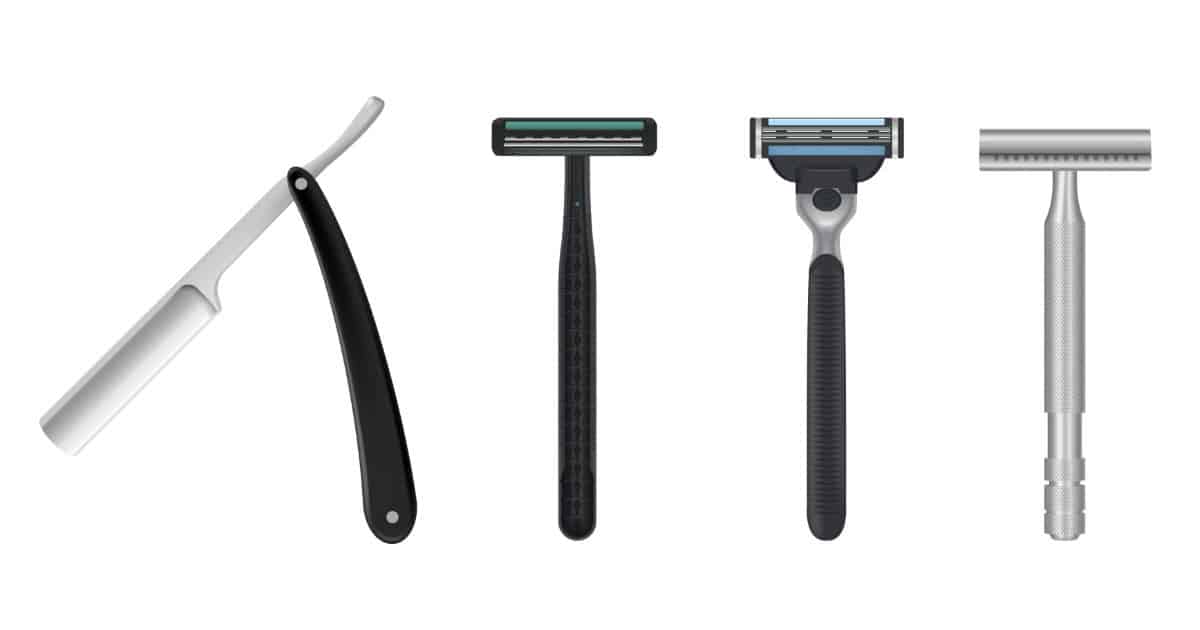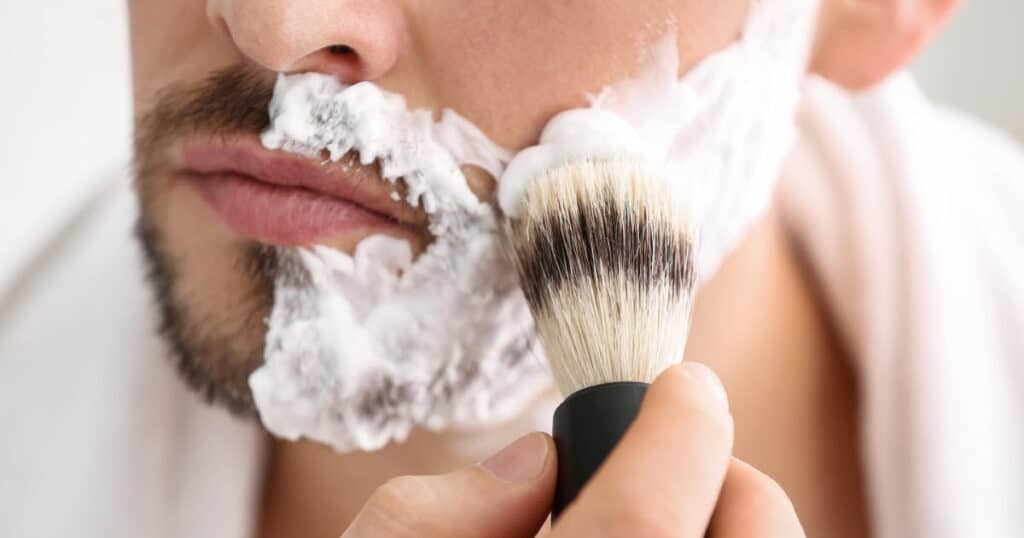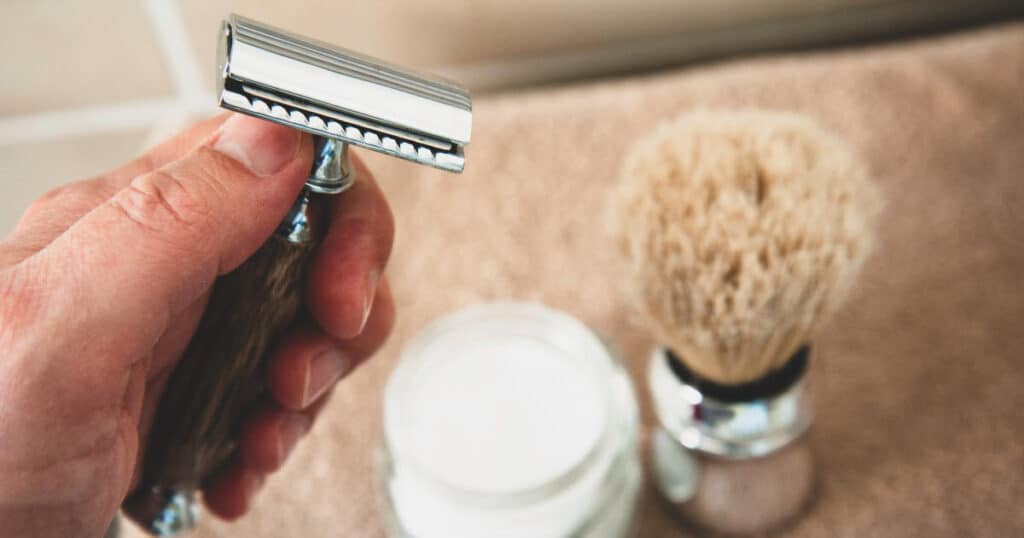Welcome! In this post, we’ll be discussing the different types of razors you can use to shave your face. Many men—particularly those who are new to shaving—don’t realize that there are a wide variety of razors available to use, and that some types of razors are (in our opinion!) way, way better than others.
We’ll start with the most common type of razor—that would be the cartridge razor—and then we’ll move on to our more exotic options: safety razors (which offer a very, very close shave) and straight razors (which offer an extremely close shave). After that, we’ll talk about some alternative options (namely, electric shavers and beard trimmers).
There’s a lot of info here, and by the end you should be something of an expert on the various types of razors you can use—as well as the different styles of shaving—and you should have a very clear idea of which might be right razor for you.
Razor Types: The Basics
Basically, there are only three types of “real” razors: disposables/cartridge razors, safety razors, and straight razors. After that, you’ve got the machines: electric shavers and beard trimmers. There’s a lot of information below, so try to keep that in mind as you read.
First Up: Cartridge Razors and Disposables
These are the two most-accessible options. They’re easy to use, and they’re available at almost any grocery store, 7-11, bodega, etc. If you’re totally new to shaving, these are what probably come to mind.
We’ll start with disposables. These are usually made of a light-weight plastic (usually bright blue or bright yellow, for some reason), and they contain one or two or three blades. They look like this:
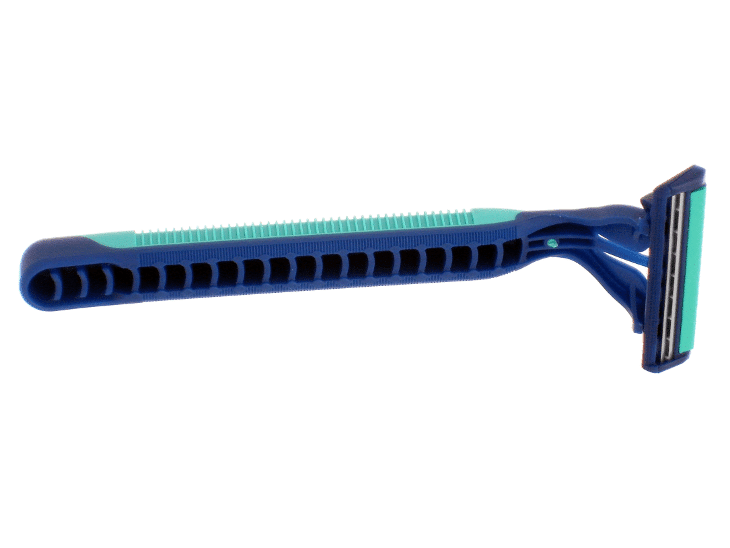
Disposables come in little plastic bags that contain anywhere from three to twelve razors. Some have brand names you might recognize (Gillette, BIC), others are a little less well-known (Equate). These are usually pretty basic—there may be a few extra features, like a pivoting head that allows the angle of the blades to change as it scrapes across your face, or a lubricated strip that softens your skin as you use it. The entire razor is one solid piece, and after you use the razor a couple of times, you toss the entire thing in the garbage and start fresh with a new one.
Cartridge razors, on the other hand, are not one solid piece: they consist of the razor handle, and a “cartridge” that contains blades (usually between three and six blades) that you attach to the end of the razor handle. After a couple of uses, you remove the cartridge and toss it in the garbage, and attach a new cartridge to the original razor handle. They look like this:
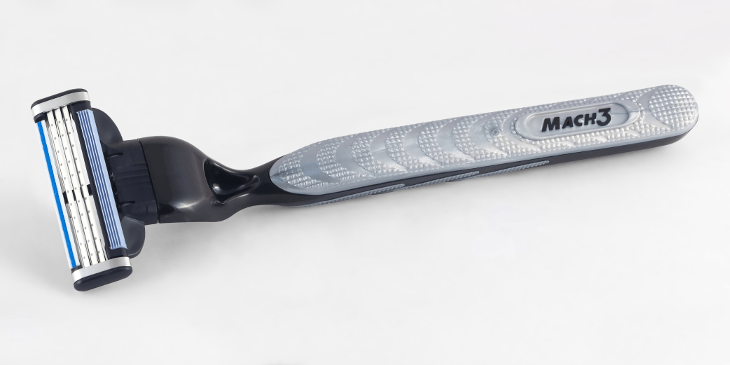
Cartridge razors are a small step up in terms of value and comfort, and they’re usually a little bit heavier than disposables (very often, the greater the weight of a razor, the more enjoyable the shave), and the razor handle is made of a sturdier plastic or metal. Many of them have the same “add-ons” that disposables have, like a lubricated strip near the blades, and a hinge on the cartridge that allows it to glide over your face as you use it. Most of the companies that make them—Gillette and Schick are the most popular—are pretty well-known.
We mentioned above that cartridge razors have between three and six blades. You may be wondering: why do cartridge razors have so many blades? The razor blade companies that made disposables and cartridge razors claim that additional blades result in a closer shave, because each successive blade cuts a whisker deeper to its root. As they explain it, the first blade pulls the whisker out of the skin and cuts it, and then the second blade cuts that whisker a little closer to the root, and then the third blade does the same thing, and then the fourth blade does the same… etc. That may be true… or it may just be a marketing ploy. It’s hard to believe that a sixth blade is going to do anything more than irritate your skin, but some men use them and like them.
Pros and Cons of Disposables and Cartridges
Disposables and cartridges get a lot of scorn from guys who are interested in traditional wet shaving. Safety razors and straight razors—which we’ll discuss below—are usually seen as the most effective / comfortable / gentlemanly way to shave, and disposables/cartridges are seen as cheap and ineffective. That’s not quite fair, though, and disposables and cartridges are still a great option for a lot of men.
Pros of Disposables and Cartridges:
The Blade is Kept at a Consistent Angle. The real benefit to these razors is that the blade is angled against your face in a way that allows for an effective shave. This is perhaps the most basic and most important rule about shaving, and it applies to whatever type of razor you decide to use: the angle of the blade against your skin determines whether you will cut the hairs on your face, or whether you will cut the skin on your face. And THAT’S the big benefit of these razors: because the blade is encased in the cartridge (in cartridge razors) and in the razor itself (disposable razors), the blade is angled to give you a decent shave. It’s much harder to hold the razor at an odd angle and cut yourself, which is often the case with safety razors and straight razors—because with those, if you hold them at an incorrect angle, you’re likely to nick your skin and bleed a little bit. Disposables and cartridges do not result in the closest or most comfortable shave in the world, but they don’t help maintain and effective shaving angle, and that’s a big plus for newbies and inexperienced shavers.
They Can Be Good for Traveling. The TSA has very strict rules about what kind of blades you can bring on a plane, and their rules about disposables and cartridges are usually the most “lax.” Very often, a single-blade disposable is an acceptable item, whereas a straight razor is basically a little knife, and you’re not getting that onto an airplane, ever. Safety razors are also not usually allowed on planes, and that leaves you with disposables and cartridges. You’ll have to check with your airline and the TSA (aka, the Transportation Security Administration, the agency Department of Homeland Security that enforces rules about airports) to be certain about what types of shaving razors you can bring, but they’re usually more accepting of disposables.
They’re Good for Headshaving and Manscaping. For all other benefits of safety razors and straight razors, they can be very difficult to use your scalp and nether-regions. Cartridges are very often a better and safer option. Also, there’s another type of razor—and this is for the scalp only—that’s called the Headblade, that’s basically a razor on wheels. It’s pretty fantastic, and it’s not as widely known as many other types of head-shaving razors—something to check out if you shave your head.
They’re Easy to Find and Require No Maintenance. As mentioned earlier, you can buy these almost anywhere, and there’s literally nothing you need to do to keep them. After a few uses, they become useless, so you toss ’em.
Cons of Disposables and Cartridges:
They Usually End Up Being More Expensive. If you were to only shave once in your entire life, these would definitely be the most affordable option: you can buy a disposable/cartridge for very cheap, whereas a safety razor or a straight razor will initially cost more. But, as you know, you’re going to be shaving for a long, long time, and the longer you shave, the more expensive those disposable razors become. Here’s a very simplified version of how it plays out, with make-believe numbers: you buy disposables, at $5 a month, for the rest of your life. Or, you buy a really good safety razor for $25 to $150, and then replace the blades for about 20 cents per blade (or about $1 per month) for the rest of your life. OR, you get a straight razor and a strop for $25 to $150 (or more), and with some maintenance, you can use that single razor for the rest of your life. Over time, the savings you get from using a safety razor or straight razor can be pretty sizable.
They’re a Bad Choice for Hairy Dudes. Disposables—and even cartridge razors—are simply not a great option if you’ve got a really hairy face, or if your facial hairs are very thick. The actual razors in a cartridge or disposable are light-weight and thin, and when they go up against tough whiskers, they lose. If you’ve got thick growth, disposables and/or cartridges are going to be ineffective, resulting in a lousy shave, and they may irritate the skin. A lot.
The Multiple Blades Catch Hairs and Gunk. After a few uses, there’s a lot of build-up between the blades (and the more blades in a cartridge razor, the more build-up there is). That build-up can be dead skin cells, shaving cream that adheres to the material of the razor head, your skin’s natural oils, small hairs, and whatever else is on your face. All that gunk is very difficult to remove from the cartridge or razor head, so as you continue to use the blade, you’re scraping all that gunk across your face and over your pores. For many men, that can lead to irritation and redness, so if you’ve got sensitive skin, disposables and cartridge razors may be adding to your problems.
There’s No “Pride of Ownership.” With a disposable, you buy it, use it, and then throw it in the garbage. It’s a dinky little thing becomes useless after a few uses. After you’ve shaved with it a few times, it goes in the trash, you don’t actually own anything. Safety razors and straight razors are manly little tools that are yours forever, and that’s a good thing. We’ll talk more about “pride of ownership” in the “Pros” section of safeties and straights, below.
They’re Kind of Gimmicky. There was a Saturday Night Live commercial parody a few years back, where Will Farrell tries out a new cartridge razor… that has 14 distinct razor blades on it. Minutes after using it, he’s in tears and bleeding all over the bathroom. It’s a funny skit, but it points to the absurdity of the “Razor Blade Wars.” Are two blades better than one? Maybe. Is three better than two? Maybe… Is four better than three? Probably not. What’s probably best is a single blade with the grain, then across the grain, then against the grain (more on that later). The point is—razor blade companies make a LOT of money off cartridges and disposables, and the add-ons—pivoting heads, gel strips, rotating balls—don’t really do much, if they do anything at all.
Again, we don’t mean to disparage disposable razors and cartridge razors. For a lot of men—most men, probably—they’re a great option and they work just fine. Buuuuuuut… in our humble opinion, safety razors and straight razors are better once you get the hang of them. We promised ourselves we’d remain unbiased (and we almost made it!) but in our experience, it’s the truth: safeties and straighties are just plain better, and we’ll discuss why in a bit.
Safety Razors: What They Are and How They’re Used
These aren’t the most popular razors in the world—of the world’s roughly 3.8 billion men, it’s likely that most of the ones in developing countries use cartridge razors, and most of the ones living in developing countries use straight razors—but among shaving enthusiasts (that is, men who know a lot about shaving and want the closest shave they can get), these are a REALLY popular option.
These are very manly, very graceful tools that provide an extremely close shave. They have a very satisfying weight—if you go from using one of these to using a disposable, the disposable will feel like a trinket—and while they’re usually more expensive that a disposable or cartridge, they literally last a lifetime: the handle and head are usually stainless steel or chrome plated, and it’s not uncommon for them to become family heirlooms that are passed down through the men in a family.
Straight razors come with a lot of different features, but here’s a basic image of one:
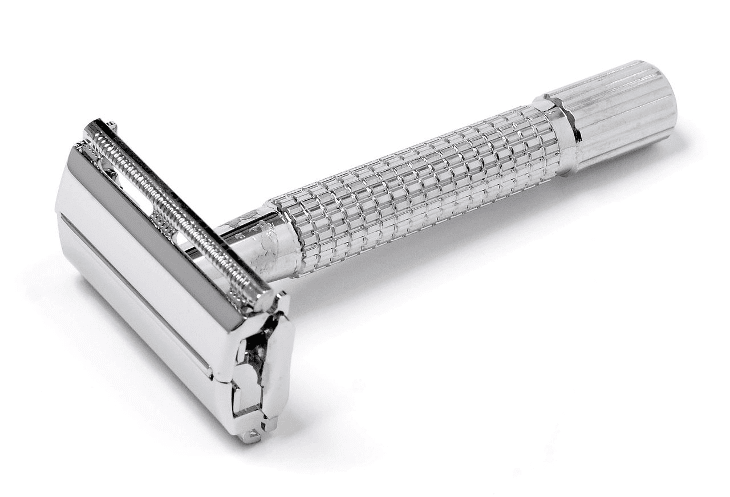
Of all the different types of razors, these are among our favorites.
Here’s how it works: the head of the tool has a removable top, which you take off to insert or remove new razors blades. When you reattach the removable head, a small portion of the razor juts out from the head, allowing you to shave with it. Once you’ve used the razor a couple of times and it becomes dull, you take off the removable head, discard the razor blade, add a new razor blade, and reattach the movable head. Wallah! It’s like having an entirely new razor every couple of days.
That may be a little difficult to visualize, so here’s a great video from Baxter of California (a fantastic company that makes wet shaving products) on how a safety razor works. Jump to 0:27 to see how it’s assembled and how to insert/remove razor blades:
We could go into a lot of detail about safety razors—and we’ve written a lot of posts that do go into a lot of detail—but here’s a quick rundown of the various features available:
Double Edge vs. Single Edge. A double edge razor blade has a cutting edge on both sides of the razor’s head; a single edge razor has a cutting edge on only one side of the head. Double edge razors are probably the more popular option of the two.
Three-Piece vs. Two-Piece vs. One-Piece Construction. Different safety razors are made with a different number of parts. A three-piece razor is made up of a handle and the two parts of the head—a top part and a bottom part—and the razor rests between these two parts of the head; a two-piece razor usually has a handle and a head that features a “flip-up” top where you place the razor blade; and a single-piece razor (sometimes called a butterfly razor) features a handle that is fully attached to a head that either flips open or twists open (the twist-to-open variety is sometimes referred to as a TTO).
By the way, butterfly razors, which we just mentioned, have a lot of dedicated fans, and we’ve written about our most-enjoyed butterfly safeties here.
Fixed vs. Adjustable. Most safety razors are “fixed,” meaning that the safety razor provides a reliably close shave, but there are a few that allow you to change the “settings” of the safety razor, so in order to get a close (or more “aggressive”) shave. Most safety razors fall into the “fixed” category, so you’ll have plenty to look into if you’re interested in one of those, but we also have a list of the adjustable safety razors we recommend, if you’d like to learn about those.
Handle Properties. The length, weight, and tactile properties of a safety razor handle are all buying options. Many people (the writers of this site included!) prefer heavier handles, as the give the tool more heft. As for length, taller gentlemen tend to prefer longer handles, as they’re easier to use, and men who travel a lot seem to appreciate shorter-handled safeties, because they’re easier to pack and stow. Lastly, while it may seem like a secondary concern, the tactility of the handle—that is, the way it feels to the touch—is a big consideration. There are smooth handles, handles with a three-dimensional patterns / grooves / ribs, and handles that have bulbs at the top or bottom.
There are a couple of other variations between safety razors, but those are a few of the most noteworthy. These may sound like very specific differences, but they actually make a very big difference in the actual shave, and safety razor users enjoy those variations and often collect different types of different razors. In fact, it’s not uncommon for safety razor aficionados to have a number of different safety razors, and choose a razor based on their mood or their shaving needs for that day (for example: if a man wants an aggressive shave, he may choose an adjustable razor and adjust it to the highest setting; if he wants a less aggressive shave (let’s say he doesn’t want to roll the dice on getting some nicks to his face, because aggressive razors can do that), he’ll go with a less aggressive non-adjustable). Many guys actually end up with a suite of safety razors, and use a different one every day.
Before we list the pros and cons of safety razors, there are two topics we need to quickly discuss. The first: the definition of “wet shaving.”
What is Wet Shaving, and Why Should I Care?
You may hear that term thrown around a lot, but what does it mean? Basically, it boils down to this: wet shaving refers to any shave done with traditional shaving tools. Those tools include:
Traditional shaving razors like safety razors and straight razors;
Traditional soaps and lathers; and
Traditional application tools, such as badger-hair shaving brushes.
If you’ve not yet gotten into wet shaving, you may be asking, “What’s the point of all this? I don’t see the big deal.” There are a lot of reasons why men become wet shavers, but the main reasons are pretty straightforward:
Wet shaving provides the closest shave you’ll ever get;
It’s a great option for men with sensitive skin or skin issues;
It’s better for the earth, because you’re not using throw-away products that clog landfills;
It’s very, very enjoyable. That’s perhaps the most selfish reason, but it’s true. A hot lather, a close shave, and an enjoyable routine with manly tools is a great way to start the day.
Rough and Tumble Gentleman is largely dedicated to wet shaving, and if you’re interested in learning more about wet shaving, we’ve got plenty of articles about it.
Why Are They Called “Safety Razors” When They Don’t Look That Safe?
Great question! The answer has to do with the history of shaving. Here’s the super, super, super boiled-down version: for centuries—perhaps even millennia—men shaved with straight razors, or something like them. We discuss straight razors in the next section, but here’s a quick image to show you what we’re talking about:
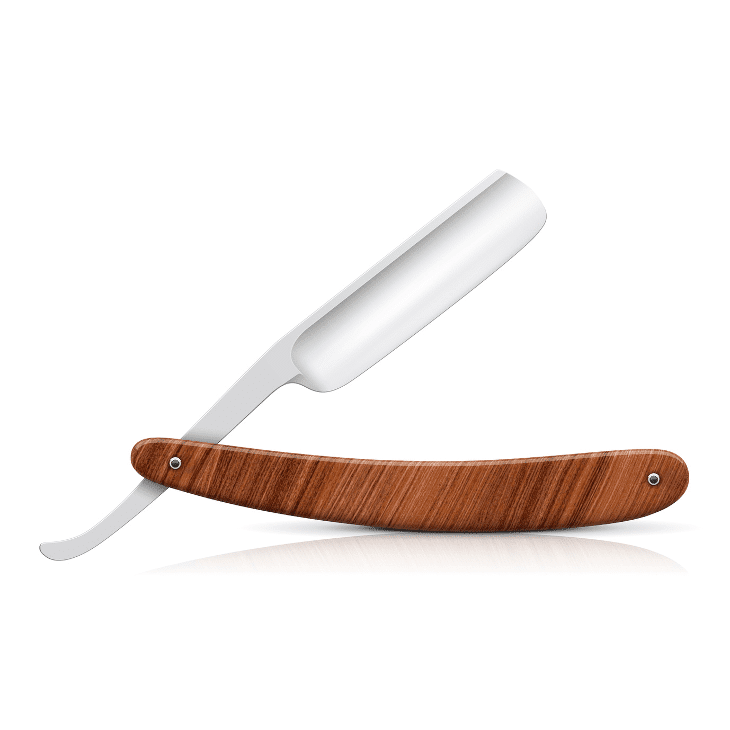
It’s basically a super-sharp knife that’s used for shaving (these are still very popular, and once you learn how to use them, they provide perhaps the closest shave a man can get). We’ll talk more about straight razors in the next section, but for our current topic—why safety razors are called safety razors—all you need to know is that straight razors will REALLY cut your face if you don’t know how to properly use them.
So because straight razors can result in a lot of cuts if you don’t know what you’re doing, manufacturers came up with a new shaving razor—one that didn’t result in as many nicks to the face—and called it a safety razor. So it’s not that a safety razor is the safest razor that you can buy—disposables and cartridges will probably result in fewer nicks—it’s that safety razors were the safest razor on the market at the time they were introduced. So if it seems a little odd to you that a shaver with an actual blade sticking out of it be called a “safety razor,” your hunch was right.
Finally:
Pros and Cons of Safety Razors
Here are some of the advantages and disadvantages of using safety razors.
Pros of Safety Razors:
They Are, Hands Down, the Most Effective Shave. Once you’ve made the switch from disposables and cartridge razors to safeties or straight razors, there’s no going back. And, because they’re such a close shave…
They’re Often a Better Choice for People with Irritable Skin. We mentioned this above, but there’s some really gross material that gets caught in disposables and cartridge razors. When you use a safety razor, you are able to fully clean the blade after every single use. (Quick note: this is true for most safety razors; there are a few types—notably one-piece razors—where that’s not the case. But, that fact remains—you’re able to get most safety razors very, very clean before you use it). If you’ve got skin issues, safety razors may be beneficial.
They’re Good for the Pocket Book. While the initial expense of buying a safety razor is definitely higher than a disposable or cartridge razor, the long-term costs can be dramatically lower. Instead of buying new disposables or new cartridges, you simply buy microscopically thin replacement blades for pennies on the dollar, and that’s it.
Safeties Are Good for the Earth. Disposables are made almost entirely of plastic, that never, ever erodes. Cartridge razors use less plastic than disposables, but there’s still a lot of plastic in the cartridge itself, and they have the same problem: they sit in landfills forever. When you use a safety razor, you can recycle your razor blades, and you can feel great about yourself for doing so.
They’re Pretty Darn Manly. Wet shaving is often referred to as “The way your Grandfather used to shave,” and there’s truth to that. Men of previous generations used safety razors and straight razors. There’s a lot of nostalgia for the “manly” eras of time past—and a lot of that may be accurate and a lot of it may not be—but it’s certainly true that men in previous generations put steel and blade to their faces, instead of some five-blade contraption that some marketing team came up with. Safety razors—and all of wet shaving, for that matter—is an embrace of traditional male grooming. That’s a nice thing to contemplate every day, and for many men, there are good feelings that come with it.
So there are some pretty fantastic reasons to use a safety razor. But, nothing is perfect, and neither are safety razors. So let’s move on to the…
Cons of Safety Razors:
There’s a Learning Period. No matter who you are, or how long you’ve been shaving, when you make the switch to safety razors, the chances of you nicking up your face and bleeding a little bit are… pretty high. There’s a learning curve to using safety razors. You can consider it a “rite of passage,” because those nicks do certainly hurt, but after a little practice, they become fewer and farther between. That’s definitely the biggest disadvantage of safety razors, but there are a number of gentle beginner models that can make the transition much easier.
There’s a Little Bit of Upkeep Involved. Before you use a safety razor, you need to make sure the blade is OK, without any nicks or defects in it; after a couple of shaves, you need to replace the blade and throw the old one out. You also need to order new blades every once in a while. Pretty easy, but still, some maintenance you’ll need to perform.
It Can Become Addictive. That sounds absurd, but it’s true: a lot of guys who get really into shaving start collecting different types of razors and different types of blades, and they love to see their collections grow. It’s called Razor Acquisition Disorder, and it’s a real thing. It’s not, like, a real problem, when compared to some of the other problems in the world, but it’s a thing.
Straight Razors: Basically Little Swords
Straight razors are the most intimidating of all razors, because they’re basically little swords. They have a very long, very open blade, and they look like this:
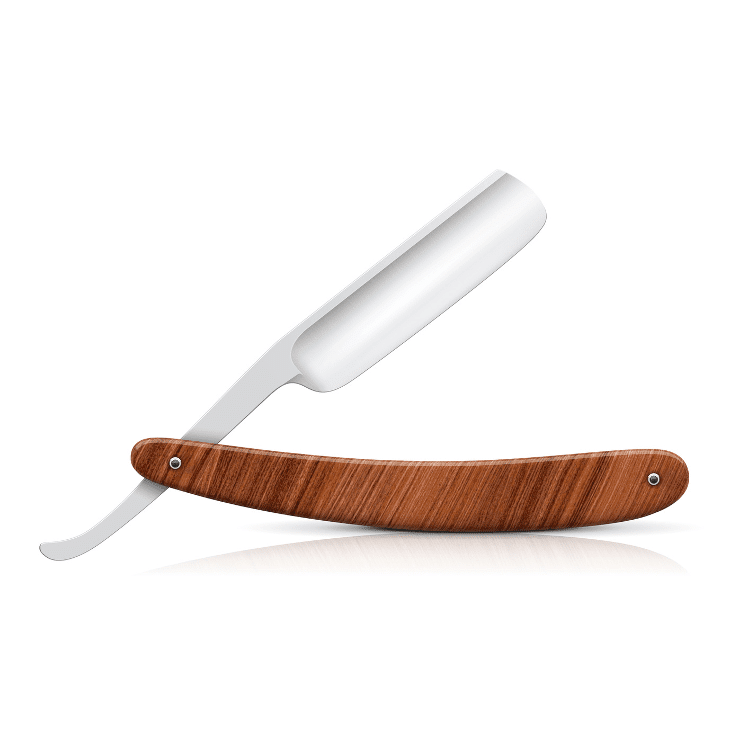
Yes, that’s the same image we included above. Good eye!
These are pretty simple, in terms of use: you sharpen them on a leather strip called a strop, and you shave with them. After use, the blade folds into the handle, which has two sides to it. If you buy a good one, you can have it for the rest of your life, and bequeath it to your sons, when that times comes. It is, perhaps, the most original way of shaving, outside of being a caveman and using sharp rocks.
Straight razors look pretty simple, but there are actually a number of differentiators that make every blade unique:
Blade Width. Most often, the blades on straight razors are either 5/8 inches wide or 6/8 inches wide, but there are longer blades up to 7/8 or 8/8 that are available;
Blade Point. This refers to the end of the blade. There are different styles of point, including square points (which is square), round points (which is round), French points, and Spanish points (the straight razor about looks like it has a round point).

Blade Grind. This refers to the cross section of the blade (that is, the view of the blade when you look at the front of the blade to the back of the handle). A blade in cross section may look like a true wedge, or it may have a “degree of hollowness” (see image). Blades with different grinds perform differently.
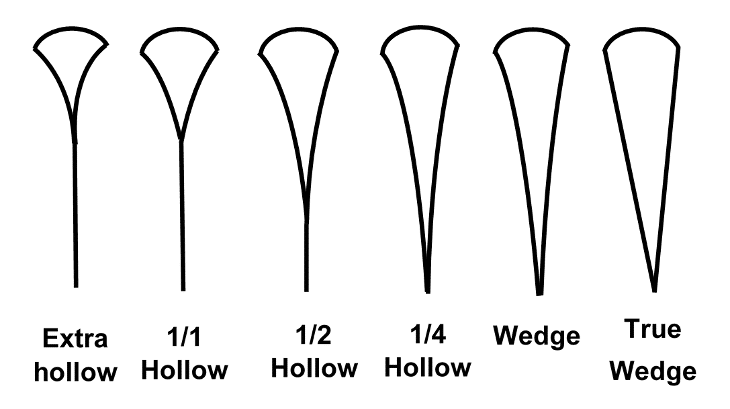
Handle Properties. Over the years, the handles or straight razors have been made with a number of different materials, including wood, bone, horn, mother-of-pearl, ivory, tortoise shell, and others. Some of the materials (such as ivory) are no longer used, but the handle remains an integral part of a straight razor, and one that is of interest to purchasers.
There are many other features, but those are among the most important. If this seems a little complicated, don’t worry about it. The parts of a straight razor are surprisingly detailed, so we wrote a (very) long post about it to explain some of the finer points. Be sure to check that out if you’d like to learn more.
Two Sub-Types of Straight Razors
Far and away, most straight razors look like the one in the photo above. However, there are two types of straight razors that we should mention. They are:
Shavettes. These are very similar to straights, but they’re smaller and they use disposable blades. Here’s a photo of some shavettes. These are really popular with barbers, because barbers can use them on a customer, and then when a new customer comes in, they can replace the blade for the new customer. It’s not only barbers who use them, though—there are a lot of gentlemen who use shavettes as their primary means of shaving.
Kamisoris. These are Japanese straight razors. There are a number of differences between kamisoris and regular straight razors, but the two biggest are: 1) the blade doesn’t fold into the handle—it remains exposed at all times, which makes it very different from ordinary straight razors (and more dangerous); and 2) the grind isn’t symmetrical, and instead has a straight edge on one side of the blade and a hollowed edge on the other side of the blade. These are gorgeous blades, and we’re fairly obsessed with them.
Pros and Cons of Straight Razors
The pros and cons of a straight razor are just about identical to the pros and cons of a safety razor: they provide an incredibly close shave, they’re good for your wallet and good for the earth, and they’re pretty darn manly. The one big difference is on the “Con” side: these are NOT for beginners. The “transition period” we discussed is just as harsh (and maybe a little harsher) than safety razors. It is very, very likely that you will cut yourself using a straight razor when you start using it, so be careful! Practice make perfect, though, and barbers all over the world use them on their customers. Guys who use straight razors rave about them, and many collect them.
Not a Traditional Razor, But You Shave with Them: Electric Shavers
OK! Moving on. Electric shavers aren’t considered in the “wet shaving” family—we’re done with the wet-shaving portion of the post—but these are a super, super popular option that wet shavers often overlook.
In the late 90s and early aughts, these were advertised extensively. You couldn’t turn on the television—especially around the holidays—without seeing three or four ads for an electric shaver. Ads seemed for these seem to have died down in recent years, but these razors remain very popular, and a LOT of men use them.
These are basically little machines that lift and cut whiskers in the skin. There are basically two types of electric razors: rotaries and foils. Rotaries look like this:
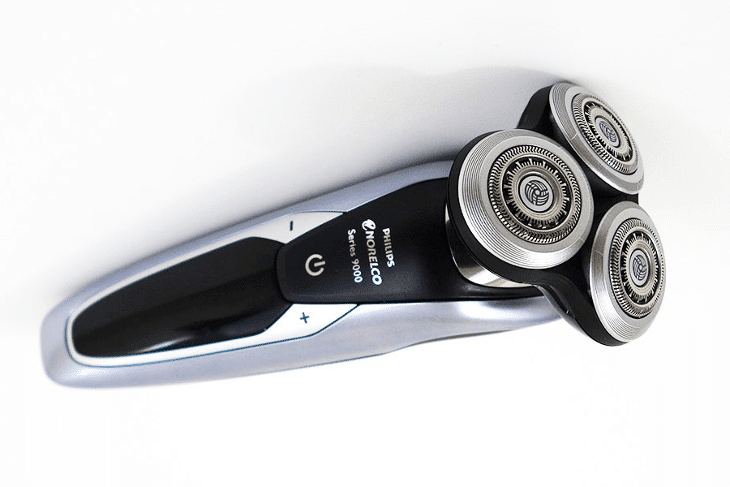
And foil shavers look like this:
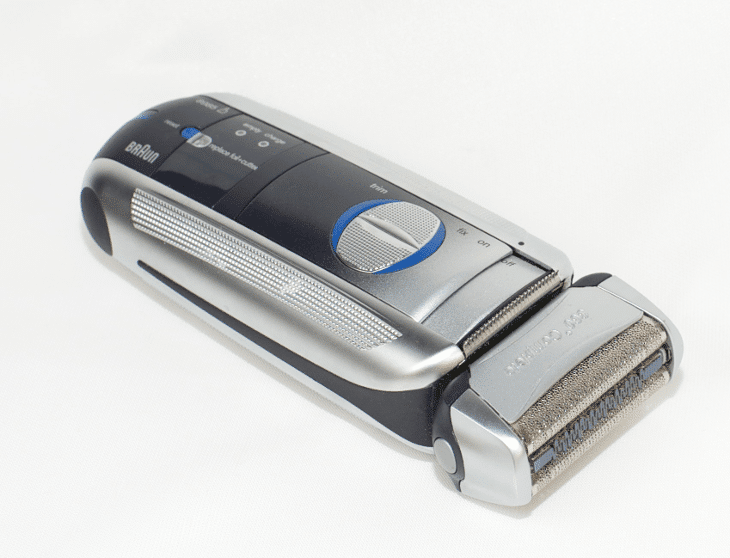
While both models effectively do the same thing, the difference between the two is at the head:
Rotaries typically have three heads that spin around at high speeds and lift the whiskers a little bit before cutting them. The flexibility of the rotary heads allows you to move the device in circular motions over your face and make multiple passes, while
Foils have none of those heads, and instead feature a thin layer of foil with razors underneath it, that also lift the whiskers a little before cutting them. These are not as flexible, and you’ll need a more deliberate path over your facial skin to shave.
Both models offer slightly different advantages: rotaries are better for gents who skip a day or two of shaving and have longer whiskers, and because the heads a little more flexible, they’re easier to navigate around under the chin and around the jaw; foils are better for detail work around sideburns and goatees/mustaches/beards, but can be a little more challenging on curved areas of the face.
The company that makes the most popular rotaries is probably Norelco; the most popular company that makes foils would probably be Braun (or Panasonic—they offer a couple of well-reviewed models as well).
Pros and Cons of Electric Shavers
While rotaries and foils are a little different, they offer the same general advantages / disadvantages.
Pros of Electric Shavers:
They’re Incredible Time Savers. One of the biggest strikes against wet shaving is that it truly does take some time—you’ve got to prep your face, create a lather, shave with the grain, shave diagonally, etc. Many guys love that—it’s part of a very comforting routine—but it does take a little bit of extra time. An electric shaver is perhaps one of the quickest ways to shave—you run the razor over your face, clean up, and you’re good to go.
You Can Roam While You Shave. Depending on the model you use, you can actual walk around the house while you shave. If you’re the kind of guy who can never stand still, a dry electric shaver unchains you from the bathroom. Some guys even use these on their faces on the drive to work (which, obviously, we don’t recommend—if you do this, you need to put down the razor and focus on driving!).
They’re a Great Option for Travelers. This is particularly true for men who travel a lot for work—you can throw the shaver in your suitcase and hit the road. Just keep in mind—if you decide to use an electric shaver when you travel, you need to know how to charge it, as well as how long the charge tends to last. Some of the newer models tend to stay charged for a while, but you’ll want to be sure. It’s a bad thing if you fly to a different city for a business meeting and look gruff because the batteries in your electric shaver ran out. Also, if the shaver uses batteries, you’ll need to make sure the batteries are charged (or you have replacement batteries).
You Can Go Dry or Wet. We’ve all seen ads or commercials where a guy is using an electric shaver on a face without shaving cream, but there are other models that actually allow the person to use shaving cream or gel (and some electric shavers even emit cream or gel from the shaver head itself). If you hate shaving cream, a dry electric shaver can be a great option—but if shaving cream is a big part of why you love shaving, there are electric razors that allow you to use creams or gels.
Cons of Electric Shavers:
Other Options Will Give You a Closer Shave. What electric shavers provide in time savings, they take away in effectiveness. Even though these models have come a long way, they still don’t provide the type of shave that a safety razor or straight razor can—in fact, we’d even go as far to say that certain cartridge razors would provide a better shave. If you have super-thick facial hair, they may not be the best choice. That said, if you’re interested in an electric, try one out! There are a LOT of guys who love their electrics, and use them for years.
They Require Some Upkeep. Electric shavers are little machines, and regardless of the type you like—foils or rotaries—they’re full of gears and wheels and bearings and so on, and they need some maintenance. Some models are much better than others, when it comes to maintenance—some only require you to remove the head and let it air-dry—but it’s definitely something to think about if you’re in the market for one. We’ve written a couple of reviews about electric shavers, so check those out if you’re interested.
Some Razors Can Be Pretty Loud. Not always a great thing if you wake up groggy and bleary-eyed.
There Is a “Transition Period.” Many men who start using an electric shaver find that during the first week or two of use, their skin is very red and very tender. There’s no official study that we could find on why that happens, but our best guess is that because the shaver’s method of removing whiskers (grabbing them, lifting them, and then cutting them at the root) is not a natural process for the skin—and it’s certainly a little more rough than simply using a single blade to cut hairs on *top* of the skin—so the skin probably has to adapt to the procedure. For most guys, a week or two shaving with an electric, and they’re back to normal, but others find it to cause continuous irritation. It’s kind of rare that the shaver would continue to irritate the skin, after a few weeks of use—after all, these things are super popular—but it does happen.
One Last Option: The Beard Trimmer
These aren’t really considered a type of razor, but we’ll include them because a lot of guys use them.
If you’re the kind of guy who doesn’t need to trim every day, these can be a great fit. These won’t do detail work for you—in fact, the razor won’t get anywhere near your skin—but they can shorten beards, whiskers, and even the hair on your head, depending on how long it is.
These are GREAT one-piece go-to for guys who are bald or balding who have very short hair on the top of their heads and scruff or beards. Turn it on, shave the hair on your face to the desired length, and then do the same with the hair on your head, and then you’re good to go. Easy peasy!
Boiled Down: Which Type of Razor Is Right for You?
If You Are New to Shaving: Cartridge shavers can be a great way to start shaving, and the Gillette Mach 3 is a good starter option. Be careful with disposables—they’re inexpensive and easy to use, but the blades they use aren’t always top quality, and you may get nicked a lot.
If You Have Thick Facial Hair or a Lot of Facial Hair Growth: A safety razor or a straight razor will work wonders for you. It will provide the closest shave you can get, period. Disposables are simply not going to work, cartridges may *almost* get the job done but they’ll gunk up pretty quickly, and electric shavers won’t be very effective (and they’ll get tough to use if you miss a few days of shaving). It takes a couple of tries to get the hang of safeties—and we’d recommend you start with safety razors, before moving on to straight razors—but it can be worth it. A lot of guys who are frustrated with disposables and cartridges and electric shavers find that shaving with a safety or a straight razor is a very enjoyable experience.
If You Have Thin Facial Hair or Not Much Facial Hair Growth: Believe it or not, if you’ve got thin hair or not too much growth, you’ve got the most options! You can choose literally any of the razors we’ve written about in this post, and go with it. Explore!
If You Want to Make Shaving an Enjoyable Routine: Get into traditional wet shaving. Check out some shaving cream, a badger-hair brush, a safety razor or a straight razor, and any of the other traditional wet shaving tools that interest you. Shaving can be a boring, tedious routine—or it can be a luxurious, comforting act that gets you in your groove for the day, and wet shaving is IT. We’ve written—pretty extensively about wet shaving!—so check out those posts if you’d like to learn more.
There You Have It! A Variety of Razors
There’s a lot here, so if you made it all the way to the end of the post, good for you! Keep in mind, this is an “overview”-type post, and we describe how to use these tools in other posts, so check them out if you’d like to learn more. Thanks for reading, and be good!
Image Credit: “Blade Hollowness Scale,” Dr. K, via Wikipedia / Creative Commons Attribution 3.0 License
Michael Morris is the head writer here at Rough and Tumble Gentleman. He's got a ducktail beard and loves Brazilian jiu-jitsu. He's married to the woman of his dreams and lives in Brooklyn, NY.

